Tired of plastic waste piling up from food containers? This pollution harms our planet and can hurt your brand’s image. Innovative biodegradable containers offer a real, sustainable alternative.
Biodegradable food containers, made from materials like PLA, bagasse, or bamboo, are changing foodservice by cutting down plastic waste. They give eco-friendly options without losing quality, meeting the growing customer wish for sustainability.
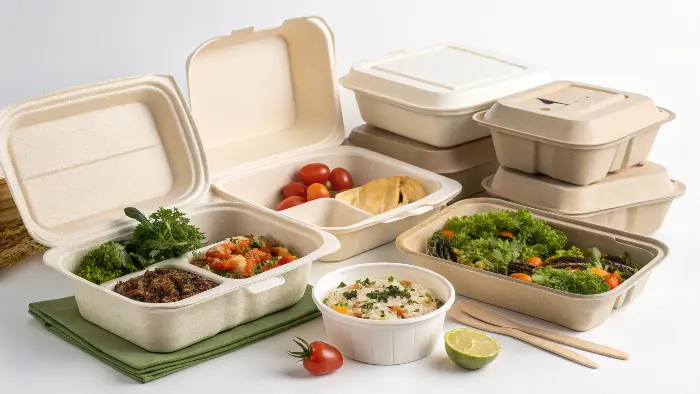
It’s a big topic, right? So many businesses, just like yours, are looking for better options. I get it, I’ve been there too, trying to figure out the best path for Ecosourcecn and our clients. Let’s dive into what makes these containers so special and what you, as someone like Jacky looking for eco-packaging, really need to know.
What are biodegradable plastics in the food industry, really?
Confused by terms like "biodegradable plastics"? You’re not alone, many are. This confusion can lead to accidental greenwashing or just picking the wrong options for your needs. So, let’s clear up what they truly mean for your food business.
Biodegradable plastics in foodservice are materials made to break down naturally under certain conditions, unlike old-style plastics. Common ones include PLA (polylactic acid) and PHA (polyhydroxyalkanoates), offering a greener choice for packaging.
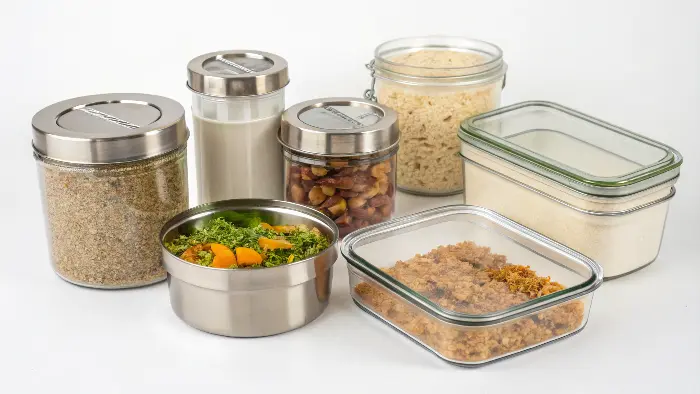
When we talk about "biodegradable" in the food container world, it means the material can be broken down by microorganisms like bacteria or fungi into natural elements like water, carbon dioxide, and biomass. But here’s a key thing: "biodegradable" isn’t always the same as "compostable." Compostable items need specific conditions, usually found in industrial composting facilities, to break down properly and within a set timeframe. I remember when we first started looking into these at Ecosourcecn, the terminology was a bit of a maze! But once you get the hang of it, you see the huge potential.
These plastics usually come from renewable resources like corn starch, sugarcane, or even potato starch. This is a big plus compared to traditional plastics made from fossil fuels. Think about PLA – it often starts as corn. Or PHA, which can be made by bacteria. It’s pretty amazing science, actually. For businesses like yours, or for packaging specialists like Jacky, understanding this difference is crucial. You want to make sure the claims match the reality. That’s why certifications like BPI (Biodegradable Products Institute) or EN13432 in Europe are so important. They verify that a product will indeed break down as expected.
Key Differences: Traditional vs. Biodegradable Plastics
| Feature | Traditional Plastic (e.g., PET, PP) | Biodegradable Plastic (e.g., PLA) |
|---|---|---|
| Source | Fossil fuels | Renewable resources (corn, sugarcane) |
| End-of-life | Landfill, persists for centuries | Biodegrades under specific conditions |
| Carbon Footprint | Generally higher | Often lower |
| Microplastics | Major contributor | Less persistent, but proper disposal is key |
So, biodegradable plastics offer a promising route, but it’s vital to know they need the right end-of-life environment to truly be eco-friendly.
So, how are these biodegradable food containers actually made?
Ever wonder about the "magic" behind eco-containers? It’s not really magic, of course! Knowing the process helps you appreciate their value and the smart thinking that goes into them. So, let’s peek into the manufacturing of these green wonders.
Biodegradable containers are usually made by processing renewable raw materials like cornstarch (for PLA) or sugarcane fiber (for bagasse) into polymers or pulp. This material is then molded into various shapes using heat and pressure.
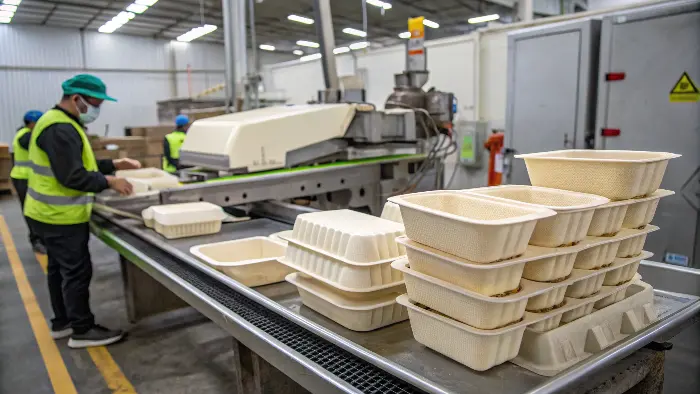
Let’s look at two popular types: PLA containers and bagasse containers. They have different starting points but similar goals.
For PLA, it often starts with something like corn.
PLA Container Manufacturing Steps
- Fermentation: Dextrose, which is a sugar from corn or sugarcane, is fermented by microorganisms. This process creates lactic acid.
- Polymerization: The lactic acid molecules are then chemically linked together to form long chains. This creates polylactic acid (PLA) resin, which usually looks like small pellets.
- Extrusion/Thermoforming: These PLA pellets are melted down and extruded into thin sheets. While still warm and pliable, these sheets are pressed into molds (thermoformed) to create the final container shapes – like cups, clamshells, or salad bowls.
For bagasse, the hero is sugarcane fiber.
Bagasse Container Manufacturing Steps
- Pulping: Bagasse is the fibrous stuff left over after sugarcane stalks are crushed to extract their juice. This fiber is mixed with water and sometimes natural binding agents to create a wet pulp, a bit like paper pulp.
- Molding: This pulp is then poured or pressed into heated molds. The heat and pressure shape the pulp into containers and also remove most of the water.
- Drying & Trimming: The formed containers might go through a final drying stage and then are trimmed to remove any excess material, giving them smooth edges.
It’s quite a journey from a plant to a plate, isn’t it? When I visited one of our partner factories, seeing the sugarcane fibers transform into sturdy, ready-to-use containers was genuinely eye-opening. It’s not just ‘mixing stuff’; it’s real science and engineering. And then there’s quality control, ensuring they meet standards for food safety (like FDA or LFGB approval) and strength. Plus, many businesses, like those Jacky works with, need customization – maybe a specific shape or their logo embossed. That’s another layer to the process we handle at Ecosourcecn.
What’s the most environmentally friendly food container then?
With so many "eco" options out there, it’s easy to feel a bit lost. Which one is truly the best for the planet? Choosing the wrong one can unfortunately cancel out good intentions or end up costing more than necessary. So, let’s compare some popular choices to help you find the greenest fit.
The "most" eco-friendly container depends on things like where the raw materials come from, the impact of making it, and how it’s thrown away. Compostable plant-based options like bagasse or PLA are strong contenders if they are properly composted.
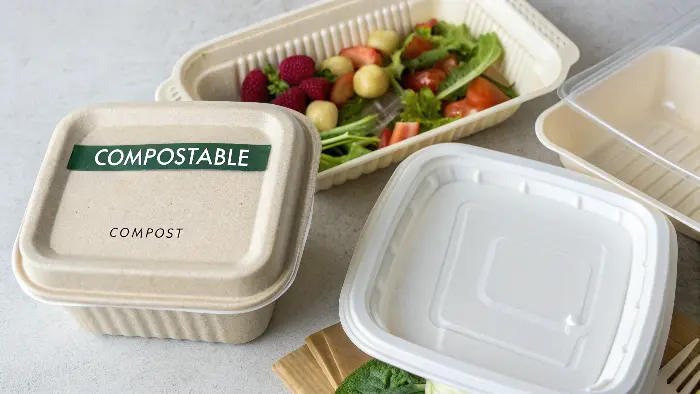
Honestly, there’s no single "perfect" answer that fits every situation. The "most environmentally friendly" choice often comes down to a few key things. We often talk about a Life Cycle Assessment (LCA), which looks at the environmental impact of a product from start to finish – from growing the raw material to its final disposal. It’s complex stuff!
Let’s look at a few common materials:
Comparing Eco-Friendly Container Materials
| Material | Pros | Cons | Best For |
|---|---|---|---|
| Bagasse (Sugarcane) | Renewable (byproduct), commercially compostable, sturdy, good for hot/cold | Can absorb moisture over time if not lined, needs composting facilities | Hot/cold foods, takeaway, events |
| PLA (Cornstarch, etc.) | Clear (like plastic), commercially compostable, renewable source | Needs industrial composting, lower heat tolerance than some, can be brittle | Cold foods, drinks, cutlery, clear lids |
| Recycled Paper/Cardboard | Reduces need for virgin trees, often biodegradable/compostable (if uncoated) | May have PFAS if not certified, not always grease/water-resistant | Dry foods, bakery items, some takeaway boxes |
| Bamboo | Fast-growing renewable, strong, often compostable | Can be more expensive, ethical sourcing is key, quality varies | Reusable options, premium disposable items |
For someone like Jacky in Canada, a big question would be: "Do my customers or local facilities have access to industrial composting for PLA products?" If the answer is no, then PLA might end up in a landfill, where it won’t break down as intended. In that case, perhaps bagasse, which can sometimes break down in a well-managed home compost (though it takes longer), or certified paper products that are widely recyclable, might be a more practical choice. It’s all about the full picture – the entire lifecycle and the local infrastructure.
I always tell our clients at Ecosourcecn, there’s no single silver bullet, unfortunately. It’s about making the best possible choice for your specific situation, your customers, and your local disposal options, and then being really transparent about it. That’s what we try to help our clients navigate.
What are the new trends shaping food packaging today?
The packaging world is always changing, isn’t it? New materials, new ideas, new rules. Staying updated is really key. If you miss out on the important trends, you might find your business falling behind competitors who are quicker to adapt. So, let’s explore some of the exciting new directions in food packaging.
Key food packaging trends include a big jump in demand for sustainable materials, simple and clean designs, smart packaging with QR codes for more info, and even edible coatings. Customization and thinking about a circular economy are also getting big.
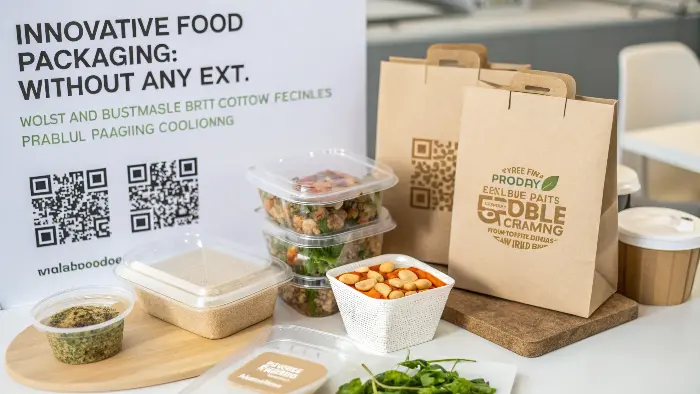
The push for sustainability is definitely the biggest driver, but there’s more to it than just "biodegradable." Here’s what I’m seeing:
Emerging Food Packaging Trends
- Hyper-Sustainability & Circularity: We’re moving beyond just "biodegradable" to materials that are fully circular (can be reused or regenerated) or even regenerative (help the environment). Think about packaging made from seaweed, mushrooms (mycelium), or agricultural waste that’s not just compostable but adds nutrients back to the soil. It’s exciting stuff!
- Minimalism & Mono-materials: Less is definitely more. Simpler designs often mean less material used, and if a package is made from just one type of material (mono-material), it’s usually much easier to recycle or compost. I’ve seen some really clever designs that use just one material for the container and lid, making disposal so much simpler for the consumer.
- Smart & Active Packaging: This is where tech meets packaging. QR codes that link to detailed sourcing information, traceability, or even recipes are becoming common. Active packaging might include elements that extend shelf life, like oxygen scavengers or moisture absorbers, or indicators that show if food is still fresh. Imagine a container telling you exactly where its contents came from and how fresh they are – pretty cool, huh? 🔥
- Edible Packaging: Yes, you read that right! Coatings made from natural substances that you can eat along with the food, or even entire packaging components that are edible. This is still a bit niche for everyday takeaway, but it’s growing, especially for things like individual sauce sachets or drink pods.
- Refill/Reuse Models: This is a big shift in thinking, moving away from single-use altogether for certain products. We’re seeing more businesses, especially in local communities, explore systems where customers bring their own containers or use durable, returnable ones provided by the business. It requires a different logistical setup, but the waste reduction potential is huge.
- Personalization & Customization: Brands want their packaging to tell their story and stand out. This is huge for us at Ecosourcecn. Helping businesses like the one Jacky works for put their unique stamp on eco-friendly packaging – whether it’s a custom shape, color, or printing – is a big part of what we do. It makes the sustainable choice also a strong brand statement.
These trends are driven by a mix of consumer demand (people want greener, smarter options!), new regulations pushing for less waste, and companies realizing that sustainable packaging can actually be a competitive advantage. It’s a dynamic space, and it’s great to be part of finding solutions.
Conclusion
Biodegradable containers are vital for sustainable foodservice. Understanding materials, processes, and trends helps businesses make impactful, eco-conscious choices for a greener future. It’s about progress, not perfection!


